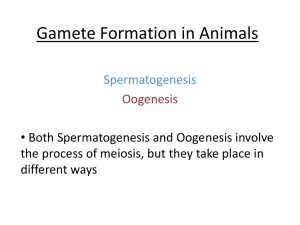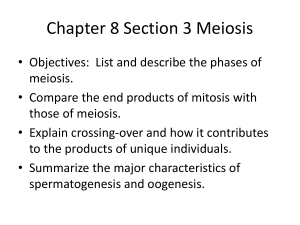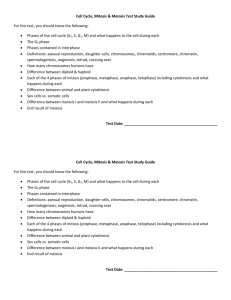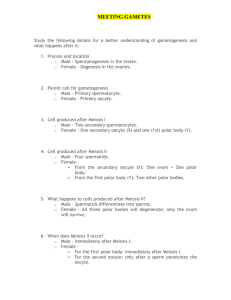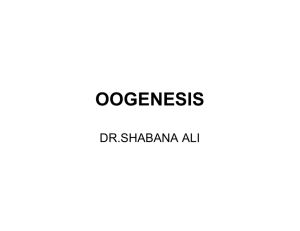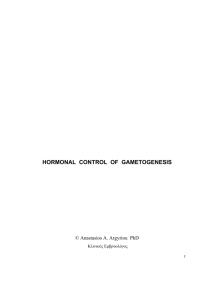Chapter 28
advertisement
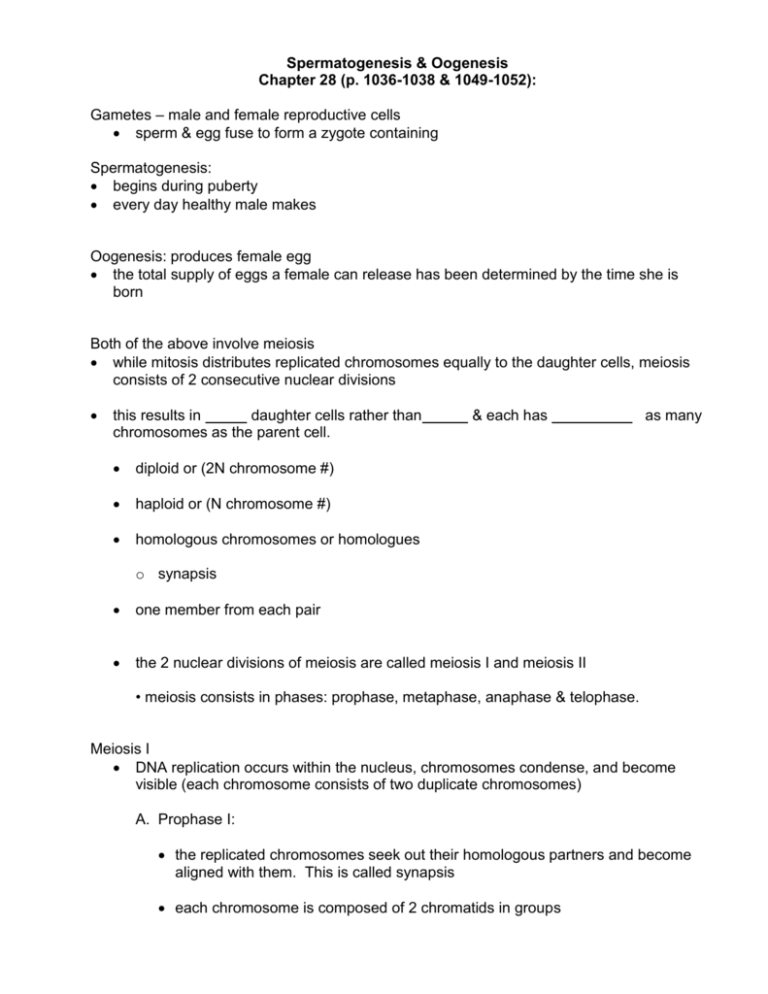
Spermatogenesis & Oogenesis Chapter 28 (p. 1036-1038 & 1049-1052): Gametes – male and female reproductive cells sperm & egg fuse to form a zygote containing Spermatogenesis: begins during puberty every day healthy male makes Oogenesis: produces female egg the total supply of eggs a female can release has been determined by the time she is born Both of the above involve meiosis while mitosis distributes replicated chromosomes equally to the daughter cells, meiosis consists of 2 consecutive nuclear divisions this results in __ daughter cells rather than chromosomes as the parent cell. diploid or (2N chromosome #) haploid or (N chromosome #) homologous chromosomes or homologues __ & each has as many o synapsis one member from each pair the 2 nuclear divisions of meiosis are called meiosis I and meiosis II • meiosis consists in phases: prophase, metaphase, anaphase & telophase. Meiosis I DNA replication occurs within the nucleus, chromosomes condense, and become visible (each chromosome consists of two duplicate chromosomes) A. Prophase I: the replicated chromosomes seek out their homologous partners and become aligned with them. This is called synapsis each chromosome is composed of 2 chromatids in groups consisting of 4 chromatids called tetrads. also during synapsis crossovers occur B. Metaphase I: tetrads line up at the center randomly C. Anaphase I centromeres don't break the homologous chromosomes are distributed to opposite ends of the cell. o Maternal to one side paternal to the other D. Telophase I nuclear membranes chromatin 2 daughter cells formed Meiosis II mirrors meiosis I except the _______ are not replicated the chromatids present in the 2 daughter cells are separated out among 4 cells. Meiosis accomplishes 2 things: 1. reduces the chromosome number by 2. introduces genetic variability: the random orientation of the homologous pairs during meiosis provides variability in the resulting gametes Spermatogenesis: spermatogonium (stem cell) undergoes mitosis to form: primary spermatocyte which then undergoes meiosis I to form: (2) secondary spermatocytes which complete meiosis II to form: (4) spermatids which mature to form: Spermiogenesis – the last step of spermatogenesis Oogenesis in fetus: oogonia (stem cells) undergo mitosis to form: primary oocytes then begin meiosis I but stalls in prophase Atresia In the ovarian cycle after puberty one egg per month continues meiosis I to form: first polar body and secondary oocyte which is ovulated (the first polar body continues meiosis II to produce two more polar bodies) Differences of oogenesis and spermatogenesis at this point: Cytoplasm of the cell divisions is uneven. Ovary releases a secondary oocyte suspended in metaphase II The ovulated secondary oocyte's fate depends on if it is fertilized: if it is fertilized it completes meiosis II to form the egg and another polar body to end up with 3 polar bodies and one ovum (fertilized) if it is not fertilized it degenerates so end up with only 2 polar bodies and degenerating oocyte Ovarian Cycle a monthly stimulation of a group of primordial follicles Step 1: Formation of Primary Follicles granulosa cells develop around the primary oocyte zona pellucida – thecal cells – Step 2: Formation of Secondary Follicles (8-10 days) granulose cells secrete small amounts of follicular fluid follicle enlarges Step 3: Formation of Tertiary Follicle 10-14 days after the start of ovarian cycle the follicle has developed into a tertiary follicle Antrum LH levels rise stimulating the primary oocyte to complete Meiosis I yielding Corona radiata Step 4: Ovulation Marks the end of the follicular phase Step 5: Formation and Degeneration of the Corpus Luteum Empty tertary follicle collapses, granulose cells invade and divide to create an endocrine structure known as Cholesterol in the CL is used to manufacture progesterone Step 6: Unless fertilization occurs, the CL begins to degenerate roughly 12 days after ovulation Corpus albicans Disintergration (involution) marks the end of the ovarian cycle



